1995 CHEVROLET SUBURBAN ESP
[x] Cancel search: ESPPage 306 of 486
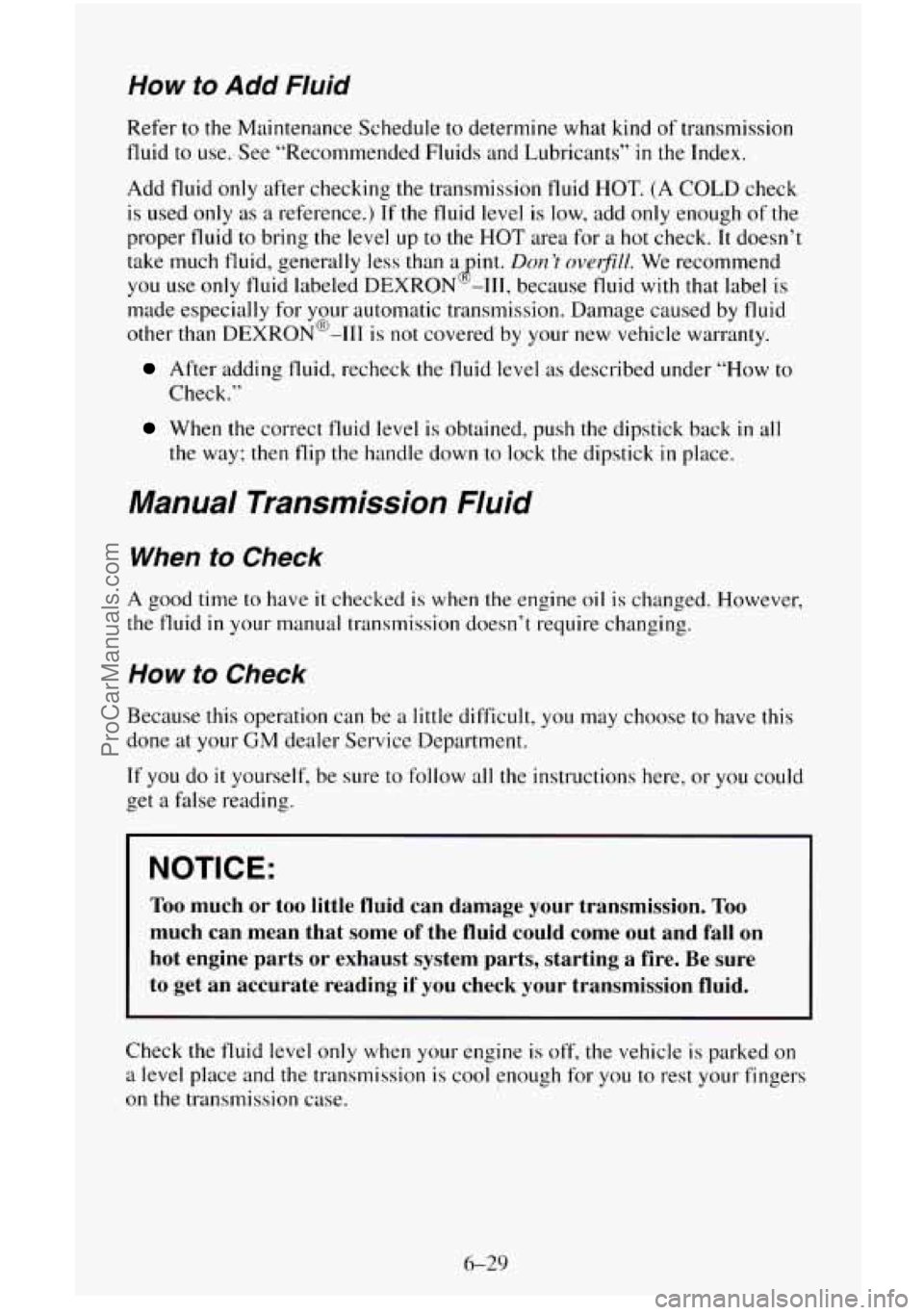
How to Add Fluid
Refer to the Maintenance Schedule to determine what kind of transmission
fluid to use. See “Recommended Fluids and Lubricants”
in the Index.
Add fluid only after checking the transmission fluid HOT.
(A COLD check
is used
only as a reference.) If the fluid level is low, add only enough of the
proper fluid to bring the level up to the HOT area for a
hot check. It doesn’t
take much fluid, generally less than a
int. Don 7 overfill. We recommend
you
use only fluid labeled DEXRON -111, because fluid with that label is
made especially for your automatic transmission. Damage caused by fluid
other than DEXRON@-111
is not covered by your new vehicle warranty.
8
After adding fluid, recheck the fluid level as described under “How to
Check.”
When the correct fluid level is obtained, push the dipstick back in all
the way; then flip
the handle down to lock the dipstick in place.
Manual Transmission Fluid
When to Check
A good time to have it checked is when the engine oil is changed. However,
the fluid
in your manual transmission doesn’t require changing.
How to Check
Because this operation can be a little difficult, you may choose to have this
done at your
GM dealer Service Department.
If you do it yourself, be sure to follow all the instructions here, or you could
get a false reading.
I NOTICE:
Too much or too little fluid can damage your transmission. Too
much can mean that some of the fluid could come out and fall on
hot engine parts or exhaust system parts, starting a fire.
Be sure
to get an accurate reading if you check your transmission fluid.
Check the fluid level only when your engine is off, the vehicle is parked on
a level place and the transmission is cool enough for you to rest your fingers
on the transmission case.
6-29
ProCarManuals.com
Page 333 of 486
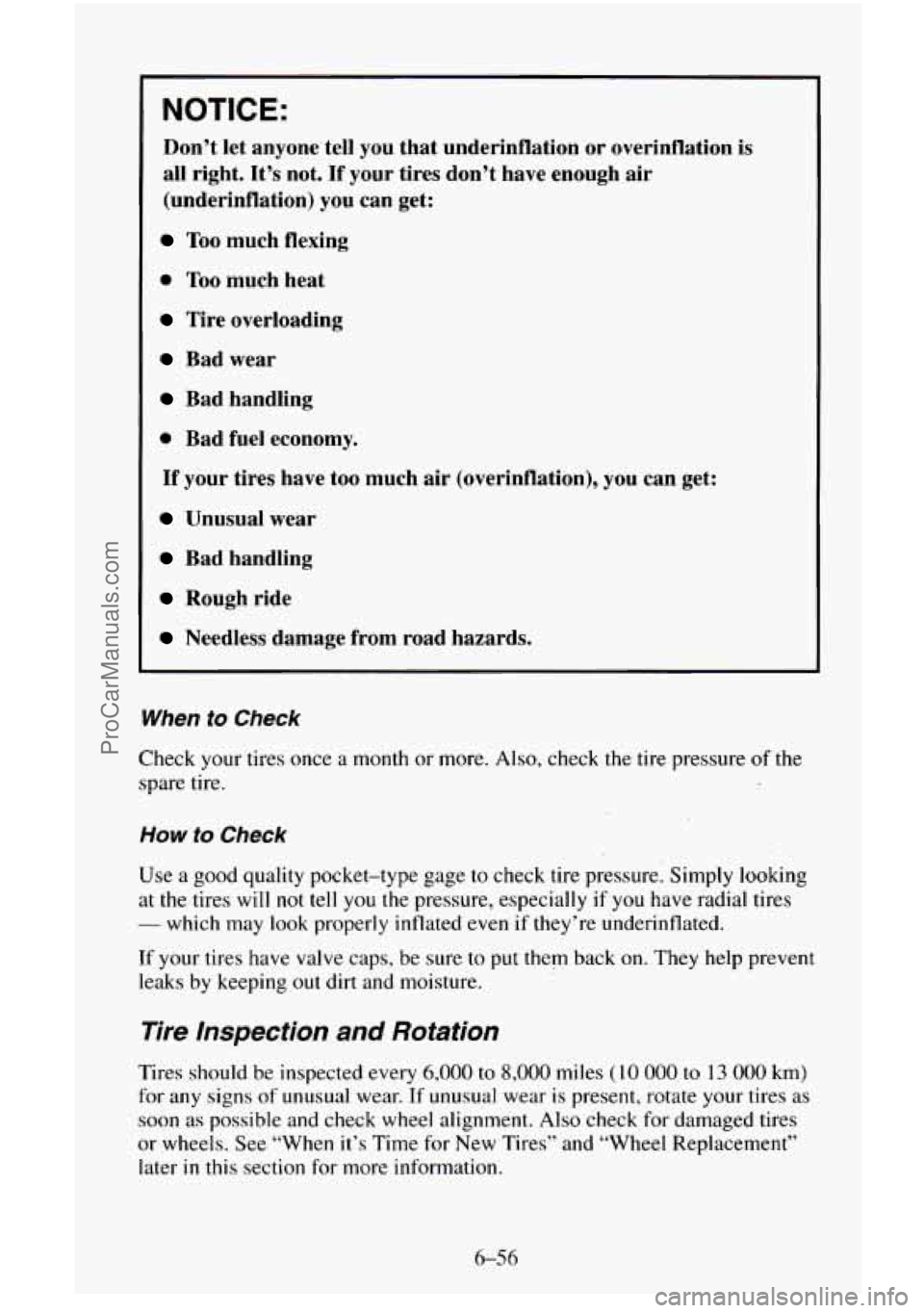
NOTICE:
Don’t let anyone tell you that underinflation or overinflation is
all right. It’s not.
If your tires don’t have enough air
(underinflation) you can get:
Too much flexing
0 Too much heat
Tire overloading
Bad wear
Bad handling
0 Bad fuel economy.
If your tires have too much air (overinflation), you can get:
Unusual wear
Bad handling
Rough ride
Needless damage from road hazards.
When to Check
Check your tires once a month or more. Also, check the tire pressure of the
spare tire.
How to Check
Use a good quality pocket-type gage to check tire pressure. Simply looking
at the tires will not tell you the pressure, especially if you have radial tires
- which may look properly inflated even if they’re underinflated.
If your tires have valve caps, be sure
to put them back on. They help prevent
leaks by keeping
out dirt and moisture.
Tire Inspection and Rotation
Tires should be inspected every 6,000 to 8,000 miles (10 000 to 13 000 km)
for any signs
of unusual wear. If unusual wear is present, rotate your tires as
soon as possible and check wheel alignment. Also check for damaged tires
or wheels. See “When it’s Time for New Tires’’ and “Wheel Replacement”
later
in this section for more information.
6-56
ProCarManuals.com
Page 336 of 486
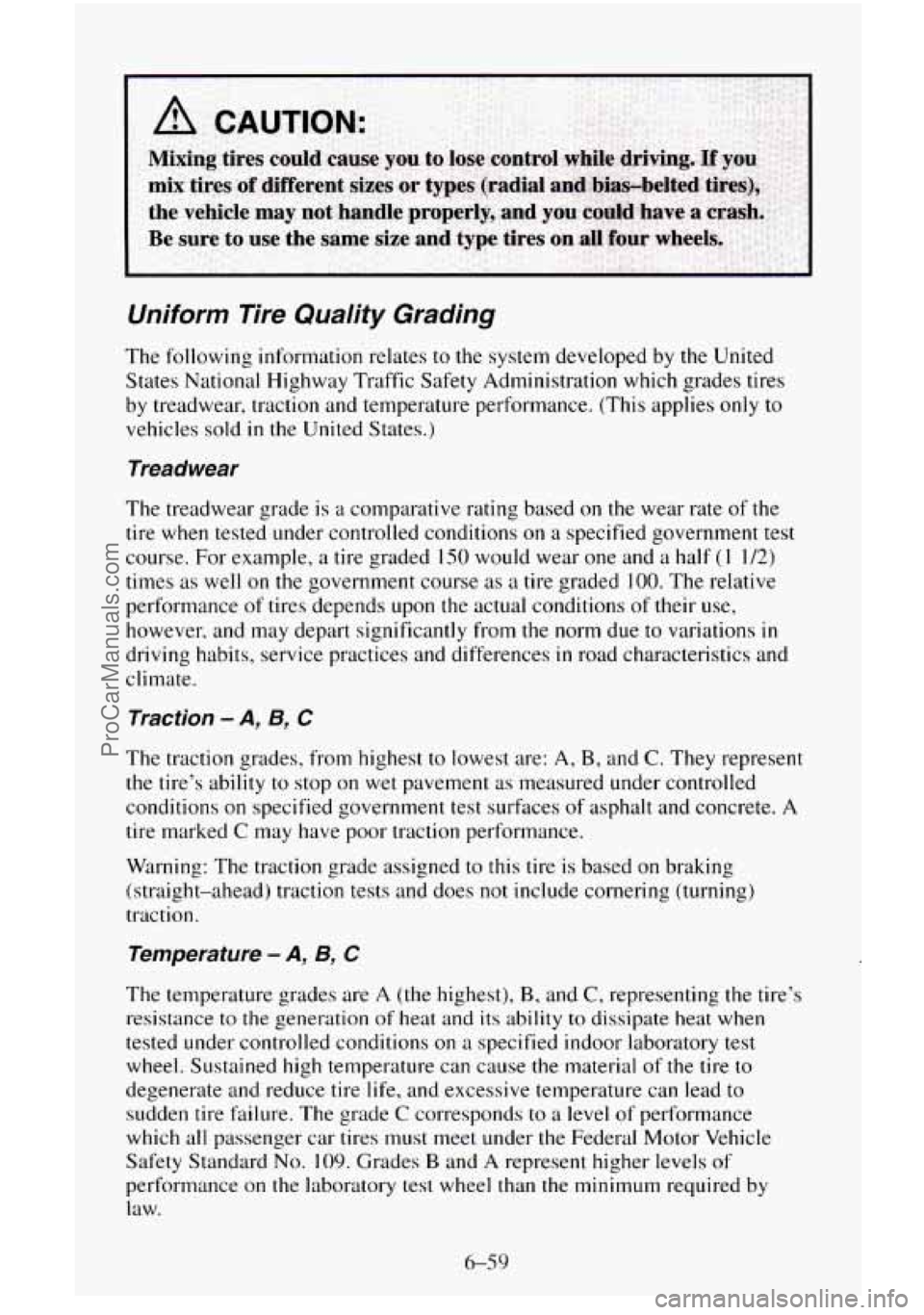
Uniform lire Qualify Grading
The following information relates to the system developed by the United
States National Highway Traffic Safety Administration which grades tires
by treadwear, traction and temperature performance. (This applies
only to
vehicles sold in the United States.)
Treadwear
The treadwear grade is a comparative rating based on the wear rate of the
tire when tested under controlled conditions on a specified government test
course. For example, a tire graded 150 would wear one and a half
(I 1/2)
times as well on the government course as a tire graded 100. The relative
performance of tires depends upon the actual conditions
of their use,
however, and may depart significantly from the norm due to variations
in
driving habits, service practices and differences in road characteristics and
climate.
Traction - A, B, C
The traction grades. from highest to lowest are: A, B, and C. They represent
the tire’s ability to stop on wet pavement as measured under controlled
conditions on specified government test surfaces
of asphalt and concrete. A
tire marked
C may have poor traction performance.
Warning:
The traction grade assigned to this tire is based on braking
(straight-ahead) traction tests and does not include cornering (turning)
traction.
Temperature - A, 6, C
The temperature grades are A (the highest), B, and C, representing the tire’s
resistance to the generation
of heat and its ability to dissipate heat when
tested under controlled conditions on
a specified indoor laboratory test
wheel. Sustained high temperature can cause
the material of the tire to
degenerate and reduce
tire life, and excessive temperature can lead to
sudden tire fdilure. The grade
C corresponds to a level of performance
which all passenger car tires must meet under the Federal Motor Vehicle
Safety Standard
No. 109. Grades B and A represent higher levels of
performance on the laboratory test wheel than the minimum required
by
law.
6-59
-- ProCarManuals.com
Page 337 of 486
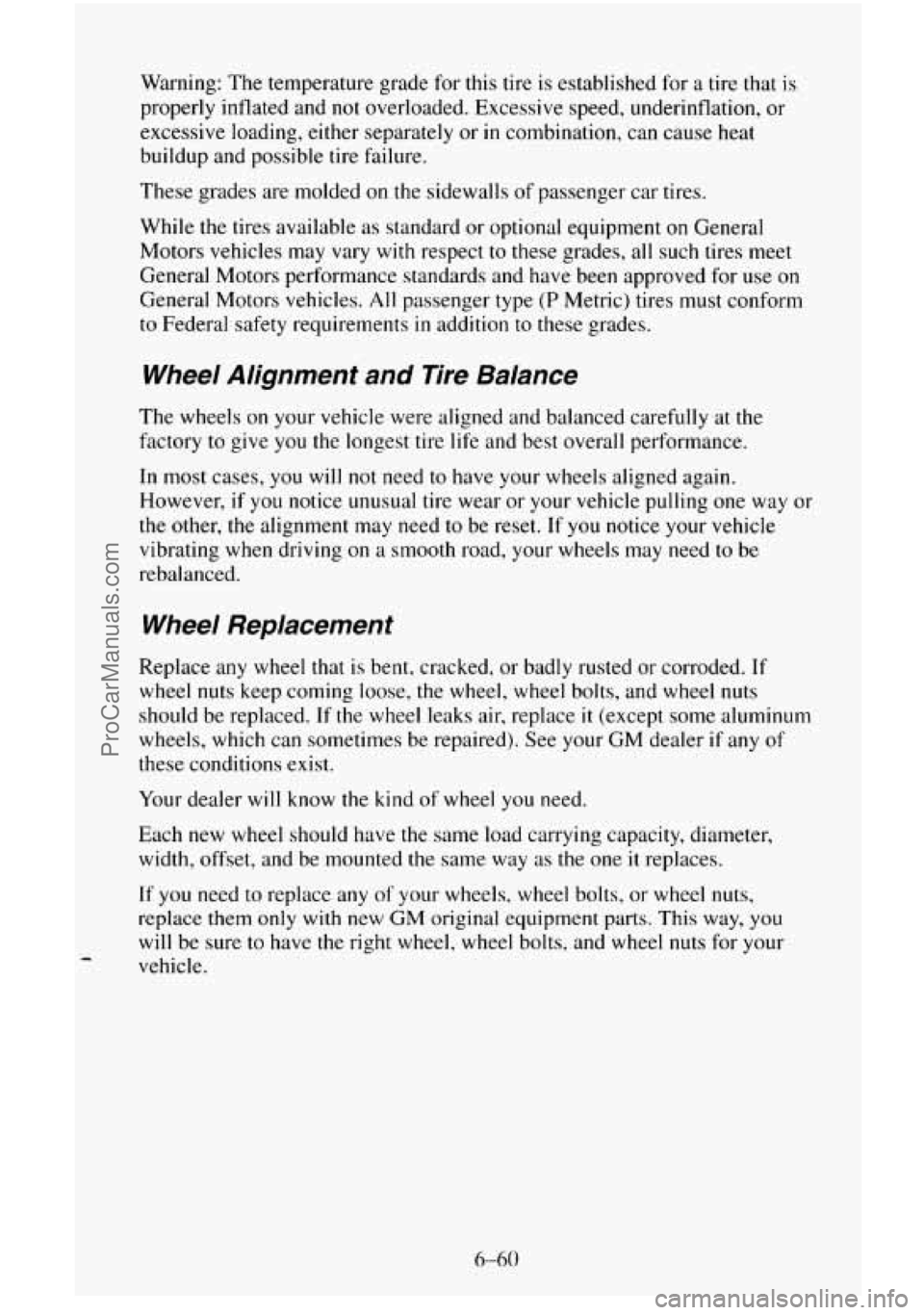
Warning: The temperature grade for this tire is established for a tire that is
properly inflated and
not overloaded. Excessive speed, underinflation, or
excessive loading, either separately or
in combination, can cause heat
buildup and possible tire failure.
These grades are molded on the sidewalls of passenger car tires.
While
the tires available as standard or optional equipment on General
Motors vehicles may vary with respect to these grades, all such tires meet
General Motors performance standards and have been approved for
use on
General Motors vehicles.
All passenger type (P Metric) tires must conform
to Federal safety requirements in addition to these grades.
Wheel Alignment and Tire Balance
The wheels on your vehicle were aligned and balanced carefully at the
factory
to give you the longest tire life and best overall performance.
In most cases, you will not need
to have your wheels aligned again.
However,
if you notice unusual tire wear or your vehicle pulling one way or
the other, the alignment may need
to be reset. If you notice your vehicle
vibrating when driving
on a smooth road, your wheels may need to be
rebalanced.
Wheel Replacement
Replace any wheel that is bent, cracked, or badly rusted or corroded. If
wheel nuts keep coming loose, the wheel, wheel bolts, and wheel nuts
should be replaced. If the wheel leaks air, replace it (except some aluminum
wheels, which can sometimes be repaired). See your GM dealer if any of
these conditions exist.
Your dealer will know the kind
of wheel you need.
Each new wheel should have the same load carrying capacity, diameter,
width, offset, and be mounted the same way as
the one it replaces.
If you need to replace any of your wheels, wheel bolts, or wheel nuts,
replace them only with new GM original equipment parts. This way, you
will be
sure to have the right wheel, wheel bolts, and wheel nuts for your
vehicle.
ProCarManuals.com
Page 466 of 486

Customer Assistance Information
Section
Here you will find out how to contact Chevrolet if you need assistance. This
section also tells you
how to obtain service publications and how to report
any safety defects.
This section includes information on: The Customer Satisfaction Procedure.
Customer Assistance for Hearing or Speech Impaired,
BBB Auto Line -
Alternative Dispute Resolution Program, Reporting Safety Defects, \
Roadside Assistance, and Service Publications.
Customer Satisfaction Procedure
Your satisfaction and goodwill are important to your dealer and Chevrolet.
Normally, any concern
with the sales transaction or the operation of your
vehicle will be resolved by your dealer’s Sales or Service Departments.
Sometimes, however, despite the best intentions of all concerned,
misunderstandings can occur.
If your concern has not been resolved to your
satisfaction, the following steps should be taken:
STEP ONE - Discuss your concern with a member of dealership
management. Normally, concerns can be quickly resolved
at that level. If
the matter has already been reviewed with the Sales, Service, or Parts
Manager, contact the owner of the dealership or the General Manager.
8-1
ProCarManuals.com
Page 476 of 486
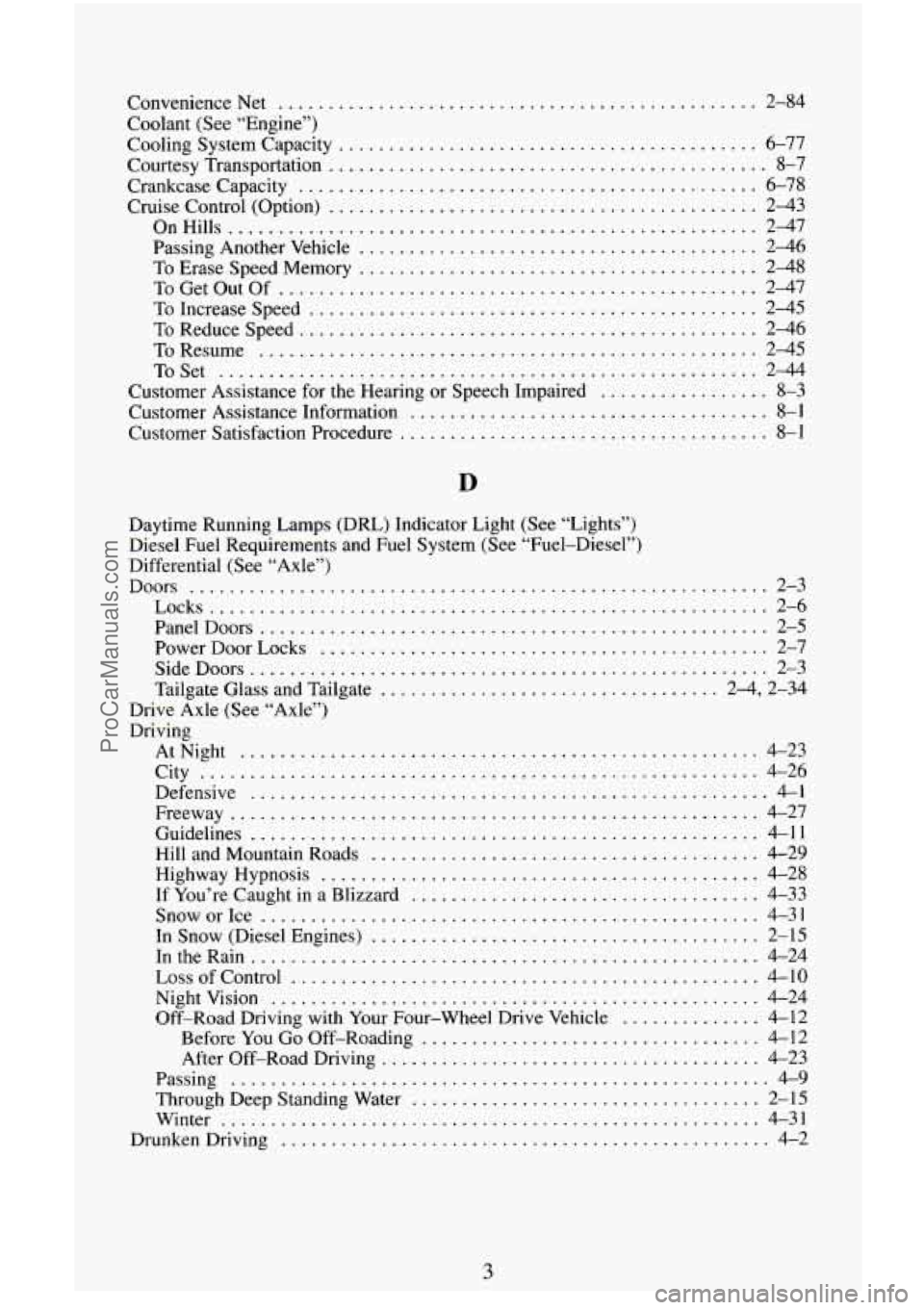
ConvenienceNet ................................................ 2-84
Coolant (See “Engine”)
Cooling System Capacity
.......................................... 6-77
Courtesy Transportation
............................................ 8-7
Crankcase Capacity
.............................................. 6-78
Cruise Control (Option)
........................................... 2-43
OnHills ..................................................... 2-47
Passing Another Vehicle
........................................ 246
To Erase Speed Memory ........................................ 248
ToGetOutOf
................................................ 2-47
ToIncreaseSpeed
............................................. 245
ToReduceSpeed
.............................................. 2-46
ToResume
.................................................. 245
ToSet
...................................................... 244
Customer Assistance for the Hearing or Speech Impaired
................. 8-3
Customer Assistance Information
.................................... 8-1
Customer Satisfaction Procedure
................................... 8-1
Daytime Running Lamps (DRL) Indicator Light (See “Lights”)
Diesel Fuel Requirements and Fuel System (See “Fuel-Diesel”)
Differential (See “Axle”)
Doors .......................................................... 2-3
Locks
........................................................ 2-6
PanelDoors
................................................... 2-5
PowerDoorLocks
............................................. 2-7
SideDoors
.................................................... 2-3
Tailgate Glass and Tailgate
.................................. 2-4, 2-34
Drive Axle (See “Axle”)
Driving AtNight
.................................................... 4-23
City
........................................................ 4-26
Defensive
.................................................... 4-1
Freeway ..................................................... 4-27
Guidelines
................................................... 4-11
Hill and Mountain Roads
....................................... 4-29
Highway Hypnosis
............................................ 4-28
If You’re Caught in a Blizzard
................................... 4-33
SnoworIce
.................................................. 4-31
In Snow (Diesel Engines)
....................................... 2-15
IntheRain ................................................... 4-24
LossofControl
............................................... 4-10
Nightvision ................................................. 4-24
Off-Road Driving with Your Four-wheel Drive Vehicle
.............. 4-12
Before You
Go Off-Roading .................................. 4-12
After Off-Road Driving
...................................... 4-23
Passing
...................................................... 4-9
Through Deep Standing Water ................................... 2-15
Winter
...................................................... 4-31
DrunkenDriving
............................................... 4-2
3
ProCarManuals.com
Page 483 of 486

New ........................................................ 6-58
Pressure
..................................................... 6-55
Spare (See “Spare Tire”)
Uniform Tire Quality Grading
................................... 6-59
Top Strap (See “Safety Belts-Child Restraints”)
Torque Lock (See “Transmission-Torque Lock”)
Towing
ATrailer
.................................................... 4-39
DrivingonGrades
.......................................... 4-45
Driving with a Trailer
....................................... 4-43
ParkingonHills
............................................ 445
Passing
................................................... 4-44
Safety Chains
.............................................. 4-42
Hitches
..................................................... 4-42
TowingYourVehicle
.............................................. 5-7
Trailer Brakes
...................................................... 4-43
Towing (See “Towing”)
Wiring Harness
.......................................... 2-85, 6-75
Trailering Package (See “Loading Your Vehicle”)
Transmission
Automatic
.............................................. 2-20, 6-26
HowToCheck ............................................. 6-26
When to Check and Change Fluid
.............................. 6-26
FiveSpeedManual
....................................... 2-23, 6-29
How To Add Fluid
.......................................... 6-30
HowToCheck
............................................. 6-29
ShiftLight
................................................ 2-24
Shiftspeeds
............................................... 2-25
Whentocheck
............................................. 6-29
Torque Lock (Automatic Transmission)
....................... 2-27, 2-29
HowToAdd
............................................... 6-29
Trip Odometer (See “Gages”)
Turn Signal and Lane Change Indicator (See “Lights”)
V
Vehicle
Damage Warnings
..................... ... ......... vi
Identification Number
..................................... 6.72. 6.73
Loading (See “Loading Your Vehicle”)
Storage
..................................................... 6-45
Symbols
............................................. vi, vu, vm, ix
Ventilation System
................................................ 3-8
Tips ......................................................... 3-8
Voltmeter (See “Gages”)
.....
W
Warning
Devices. Other
............................ .......... 5-2
Hazard Flashers (See “Hazard Warning Flashers”)
Lights and Indicators
........................................... 2-69
Alignment and Tire Balance
..................................... 6-60
Aluminum ................................................... 6-69
Wheels
ProCarManuals.com